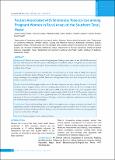Please use this identifier to cite or link to this item:
https://hdl.handle.net/20.500.14356/1616| Title: | Factors Associated with Smokeless Tobacco Use among Pregnant Women in Rural Areas of the Southern Terai, Nepal |
| Authors: | Singh, Jitendra Kumar Acharya, Dilaram Kadel, Rajendra Adhikari, Samaj Lombard, Daniel Koirala, Sumitra Paudel, Rajan |
| Citation: | SinghJ. K., AcharyaD., KadelR., AdhikariS., LombardD., KoiralaS., & PaudelR. (2017). Factors Associated with Smokeless Tobacco Use among Pregnant Women in Rural Areas of the Southern Terai, Nepal. Journal of Nepal Health Research Council, 15(1). https://doi.org/10.33314/jnhrc.v15i1.965 |
| Issue Date: | 2017 |
| Publisher: | Nepal Health Research Council |
| Article Type: | Original Article |
| Keywords: | Nepal Pregnant women Smokeless tobacco |
| Series/Report no.: | Jan-April, 2017;965 |
| Abstract: | Abstract Background: Tobacco use among women during pregnancy leading to poor maternal and child health outcomes has been well documented. However, factors influencing use of smokeless tobacco in Nepal has not yet been well established. This study aims at exploring the factors related to smokeless tobacco use among pregnant women in rural southern Terai of Nepal. Methods: A community-based cross-sectional study was performed at 52 wards within 6 Village Development Committee in Dhanusha district of Nepal. A total of 426 expectant mothers in their second trimester were selected using a multistage cluster sampling method. Descriptive and regression analyses were done to explore the factors that influence smokeless tobacco use. Results: In a total of 426 pregnant mothers, one in five used tobacco in any form. Among the users, 13.4% used smokeless tobacco. Pregnant mothers who were smoking tobacco (AOR 6.01; 95% CI (1.88-19.23), having alcohol consumption (AOR 3.86; 95% CI (1.23-12.08), stressed (AOR 5.04; 95% CI (1.81-14.03), non-vegetarian (AOR 3.31;(1.84-13.03), not attending regular mothers’ group meetings (AOR 4.63; (1.41-15.19), and not-exposed to mass media (AOR 5.02; (1.89-13.33) were significantly associated with smokeless tobacco use. Similarly, mothers of age group 20-34 years, dalit, aadibasi and janajati, hill origin, no education and primary education were more likely to use smokeless tobacco than their counterparts. Conclusions: Factors such as smoking tobacco, alcohol consumption, stress, and poor education were found to be significantly associated with smokeless tobacco use among pregnant women in southern Terai of Nepal. This requires an immediate attention develop an effective strategy to prevent and control smokeless tobacco use among pregnant women in southern Terai of Nepal. Keywords: Nepal; pregnant women; smokeless tobacco. |
| Description: | Original Article |
| URI: | http://103.69.126.140:8080/handle/20.500.14356/1616 |
| ISSN: | Print ISSN: 1727-5482; Online ISSN: 1999-6217 |
| Appears in Collections: | Vol. 15 No. 1 Issue 35 Jan-Apr 2017 |
Files in This Item:
| File | Description | Size | Format | |
|---|---|---|---|---|
| 965-Manuscript-1854-1-10-20170608.pdf | Fulltext Download | 236.45 kB | Adobe PDF |  View/Open |
Items in DSpace are protected by copyright, with all rights reserved, unless otherwise indicated.
